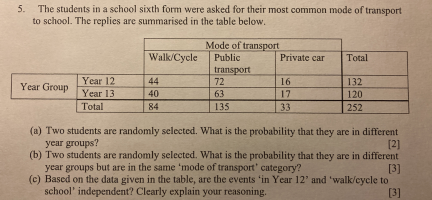Oreo_chord
New member
- Joined
- Jan 10, 2022
- Messages
- 5
View attachment 30590
Hi all, I’m new to this site!
Question 5 is one that I’ve been struggling with and just needed some help with a) b) and c), although I think I’ve got the answer for a) as 880/1757. I’m just unsure how to start answering b and c.
Thank you! Any help would be appreciated!

Do you realize that: [imath]2\cdot\left(\dfrac{132}{252}+\dfrac{120}{252}\right)=2~?[/imath]For a, I have drawn it as a tree diagram to get 2 x (132/252 + 120/252) and get 880/1757
Sorry, I meant 2 x 132/252 x 120/251. To represent the probability of picking a year 12 student and then picking a year 13 student and the x 2 represents the fact that the fraction would be the same if it was a year 13 student picked first, and then a year 12 studentDo you realize that: [imath]2\cdot\left(\dfrac{132}{252}+\dfrac{120}{252}\right)=2~?[/imath]
How is that probability?
Ok thank you, that’ll be my next stepFor b) have you listed out the possibilities of having a different year and same mode of transport? You can't calculate probabilities without knowing the possibilities.
Yes that all makes sense and thank you for taking the time to respond, however I don’t believe I’ve interpreted the question in the context of replacement? I have shown that once chosen, the person is not being placed back, as in my previous message you can see my workings of 2 x (132/252 + 120/251). My second fraction would not have a denominator of 251 if I was doing the question in the context of replacement? Also my answer was 880/1757 which as a percentage is 50.08%.First, please note that we cannot be absolutely sure what the problem even means. Your interpretation that there is selection with replacement may be correct, but that interpretation seems highly doubtful to me.
What is the probability that I pick one from 12 group and then one more from the 12 group
[math]\dfrac{132}{252} * \dfrac{131}{251} \approx 27.34\%[/math]
What is the probability that I pick one from 12 group and then one more from the 13 group
[math]\dfrac{132}{252} * \dfrac{120}{251} \approx 25.04\%[/math]
What is the probability that I pick one from 13 group and then one more from the 13 group
[math]\dfrac{120}{252} * \dfrac{119}{251} \approx 22.58\%[/math]
What is the probability that I pick one from 13 group and then one more from the 12 group
[math]\dfrac{120}{252} * \dfrac{132}{251} \approx 25.04\%[/math]
Thus the probability of getting one from each group is 50.08%
One way to give a test of the reasonableness of that result is to add the probabilities. We get 100.00%.
That is comforting (although not 100% fool proof). It suggests that 50.08% is the desired probability.
Another way to check you result is to compute it a different way.
How many ways can you choose 1 person from 132. Obviously 132. How many ways can you choose 1 person from 120. Obviously 120. So the number of ways to choose one from each group is 132 * 120.
How many ways can you choose 2 people from 252.
[math]\dbinom{252}{2} = \dfrac{252!}{2! * 250!} = \dfrac{252 * 251 * 250!}{2! * 250!} = 126 * 251.[/math]
Thus the probability of choosing one from each group is
[math] \dfrac{132 * 120}{126 * 251} \approx 50.08\%.[/math]
Do those calculations and that interpretation make sense to you?
Yes, you are correct that [imath]2=\left ( \dfrac{132}{252} + \dfrac{120}{251} \right )[/imath] does not imply replacement.Yes that all makes sense and thank you for taking the time to respond, however I don’t believe I’ve interpreted the question in the context of replacement? I have shown that once chosen, the person is not being placed back, as in my previous message you can see my workings of 2 x (132/252 + 120/251). My second fraction would not have a denominator of 251 if I was doing the question in the context of replacement? Also my answer was 880/1757 which as a percentage is 50.08%.
Thank you for showing me another method of checking.
I'd agree that combinatorics are the most efficient way to do counting problems, but you and @pka are suggesting the hypergeometric distribution, which requires the understanding of basic combinatorics. You would have to explain the [imath]{n \choose k}[/imath] notation, factorials [imath]n![/imath], and counting in probability. Given the problem in the table, it suggests that the level of understanding of probability is elementary. I don't think it's appropriate for the current level.beginning students often feel that the tree approach is more intuitive. However, the alternative method recommended by pka is frequently far more efficient and less error prone. I started with your tree approach not because it is efficient but because it seemed to be the way your thinking inclined.
